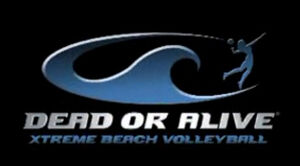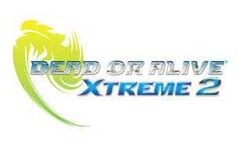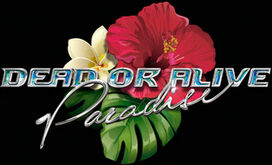Template:InfoBox Series
Dead or Alive (デッド・オア・アライブ, Deddo oa Araibu) is a series of video games developed by Team Ninja and produced by Tecmo Koei; formally Tecmo.
Primarily, Dead or Alive is composed of fast-paced fighting games. The first Dead or Alive was released in 1996 for arcades, which was well-known for its advanced graphics for that time.
Today, the Dead or Alive series consists of five main fighting games, ten remakes and ports, three beach volleyball-based spin-off titles, and a blackjack spin-off across thirteen different video game platforms. It has also spawned a feature film, DOA: Dead or Alive, which is loosely based on the game series.
The story and characters of Dead or Alive are the creation of Tomonobu Itagaki, who also "rebooted" the Ninja Gaiden series. Although Itagaki left the Tecmo company in 2008 due to business issues, Team Ninja was taken over by Yosuke Hayashi and the series was able to continue.
Over the years, Dead or Alive has been praised for its impressive graphics and fighting system; however, it has also been the subject of controversy due to how the sex appeal of its female character is viewed and used in the series.
Plot Overview

The original series logo.
Dead or Alive is set in a world similar to real life, however humanity has an advanced understanding and development in science, where organizations can gain the technology for genetic experiments, and create high-tech weaponry and transport. In addition, traditional and archaic ways of life - such as the ways of the shinobi - are still present in certain places of the world, and supernatural creatures from folklore are real living beings.
The series features a cast of martial artists of various combat styles, nationalities and backgrounds, who take part in a worldwide tournament called the "Dead or Alive World Combat Championship", held every year by the Dead or Alive Tournament Executive Committee, whose corrupt Head of the Development Victor Donovan secretly uses as a way to find spesimen for the creation of "the ultimate fighter" - a humanoid bio-weapon - through genetic experiments.
The main plot revolves around the growing war between DOATEC and the Mugen Tenshin Ninja Clan, who seek to destroy the committee for years of abductions and unwilling experimentation. After the fourth tournament, the rightful Head of DOATEC, Helena Douglas was able to reform the committee, though the feud still continues with Donovan's new organization MIST.
Following the revival of the Ninja Gaiden series in 2004, both Dead or Alive and Ninja Gaiden were given a shared universe with the latter becoming a prequel series to the former.
Development History
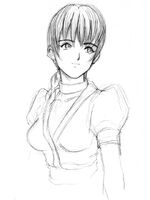
Early concept art of Kasumi, who is now seen as the official "poster girl", "character mascot" and main protagonist of the series.
1992-1998 - Conception and First Release
The Dead or Alive series was created by Tomonobu Itagaki, who is regarded by the game development community for his outspoken and stubborn nature in the development of the series.
Before the release of the Dead or Alive, Itagaki was hired as a graphics programmer for Tecmo in 1992, which was in need of brand of video games to establish a sufficient market. In this vein, Itagaki made a wager with the head of the company, assuring the president he would create a video game that would garner a competent fan base.
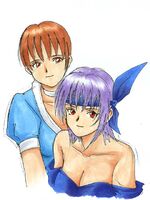
Concept art of Kasumi and Ayane for the PlayStation remake of Dead or Alive.
Because of the pressure placed on game, Itagaki named it "Dead or Alive" to demonstrate that the company's future rested on the game's success, and proceeded to form a division in the company named "Team Ninja" in 1995.
Revealed in a December 2004 interview by Game Informer magazine, Itagaki's inspiration for the series derived from the Fatal Fury series from Japan, and the American Mortal Kombat series. During development, he based the game's fast gameplay and sexual appeal from the former, and the series' ability to knock opponents off landscapes from the latter:
"I wanted to do something that would attract people's attention as I worked on the DOA game. Of course, DOA is known for its bouncing breasts. Well, I didn't come up with that idea originally. I actually got the idea from one of SNK's 2D fighting games "Garou Densetsu". Of course, when I applied it to a 3D game, it was almost too much for people. And of course, it hurts to fall off from high places in DOA, but the idea came from "Mortal Kombat". In the case of "Mortal Kombat", the 2D fighter, the character falls off and he simply dies. That ends the game. That's it. But we figured it would be more interesting to have the character continue to fight after the fall. And that's what we did..."
On Itagaki's view on how he wished the series to contribute to the fighting genre, he replied:
"...I want people to remember DOA as a game that was very aggressive and combative. As to the first question - how it contributed to the fighting genre - I look at it as something similar to how sushi was released in this country and became mainstream. You know, like, some people like graphics, some people like animation, some like flashy character design and so forth. Through DOA, we want to reach out to those people and become somewhat of a mainstream game.
Dead or Alive was released in 1996 as an arcade game. It had been a success in Japan, but not in the West. This was possibly because it was competing against Tekken, which was already a popular fighting game series for the PlayStation.
Dead or Alive was later ported to the Sega Saturn in Japan on October 9, 1997, and a improved version was later released on March 12, 1998. The PlayStation version was released in North America on March 31, 1998, and later in Europe on July 1998. Tecmo also released Dead or Alive++ for the arcades in Japan, based on the PlayStation version with an even slight updated gameplay that later expanded for the sequel.
1999-2000 - Dead or Alive 2
Following the success of Dead or Alive, a sequal called Dead or Alive 2 was released for arcades in 1999 and was later ported for the Dreamcast and PlayStation 2 in 2000.
Itagaki and his team were only given two months initially to produce the first PlayStation 2 port. At the end of this, one of his managers asked to borrow a copy to play, but instead sent in to a production factory. Itagaki was upset by not being able to finish the game on his own terms and fell into a depression during which he briefly considered quitting the industry.
Dissatisfied with the release versions of Dead or Alive 2, Team Ninja continued enhancing it on both the Dreamcast and the PlayStation markets as they worked towards their vision of the ultimate fighting game. On October 26, 2000, Tecmo released a last major update titled Dead or Alive 2: Hardcore for the PlayStation 2. Even with all the changes, Itagaki was still not happy with Hardcore. He is quoted as saying in the DOA 3 booster disc video: "They wanted a launch title in 3 months. I needed 4." Despite this, Dead or Alive 2 gained a $2 million profit in sales.
2008 - Itagaki's Departure from Tecmo
On June 2, 2008, Itagaki announced that he was resigning from Tecmo and was suing the company for withholding a bonus promised for his previous works. He was also suing Tecmo's president Yoshimi Yasuda for damages based on "unreasonable and disingenuous statements" made in front of Itagaki's colleagues.
Itagaki stated that this would unfortunately lead to the end of production for the series. However, Tecmo replied with the announcement that Team Ninja would not be dissolved upon Itagaki's departure, stating that both the Ninja Gaiden and Dead or Alive franchises would remain in production and that some projects were already underway. Soon after Yosuke Hayashi was made the new head of Team Ninja.
Gameplay
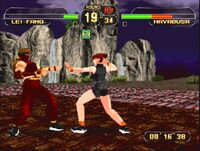
A screenshot of Ryu Hayabusa and Leifang from the first Dead or Alive
The Dead or Alive series focuses on fast-paced gameplay in a three-dimensional playing field. In comparison to other fighting series in its genre, such as Virtua Fighter, the series places emphasis on striking characters quickly and efficiently. There is an emphasis on "juggling", since countering and fast recovery times make striking risky at times, which prevents slow, technical sets of moves in most instances.
One of series's most innovative additions to the genre is its countering system. Beginning from the original Dead or Alive, players could input a backwards directional input in co-operation with the respective guard button to defend against a character's attack while dealing significant damage to the victim's life bar. Counter holds must be timed correctly with an attack, and also must be executed correspondingly with the area of attack. For example, a character that successfully counters a low kick attack from another player must time the input as well as place a downward directional push on the joystick.

A screenshot of Tina Armstrong and Lisa Hamilton as "La Mariposa" from Dead or Alive 4.
Like other modern fighting games that attempt to emulate the real life martial arts, the input system in Dead or Alive is modeled on the controls to correspond to the actions being carried out by the avatar; a forward directive punch would most likely be executed with the punch input and the pressing of the directional pad in the appropriate direction.
The series controls also make the instances of speed and simplicity more congruent with the focus of timing and combos in mind, as the commands for basic attacks are widely considered more straightforward than most video games. There is only one button for punch, kick, throw and guard, with the player rarely having to combine more than two different input schemes together at a time. There is a general "rock-paper-scissors" element to the game and essentially boils everything down to timing and ability to read the enemy's style.
In Dead or Alive 2, the series implemented its tag fighting system, allowing characters to switch back and forth for combo attacks and even attack simultaneously when timed correctly. The tag mode also included special throws unique to certain pairs of characters and allows for the participation of four players, something not common in the genre.
Games
Main Series
So far, there have been five main Dead or Alive titles. With the exception of the third and fourth titles, a number of ports and remakes have been produced of these games.
Dead or Alive
- Arcade release: November 1996 (JAP)
- Sega Saturn release: October 8, 1997 (JAP)
- PlayStation release: March 12, 1998 (JAP); March 31, 1998 (NA); July 1998 (EU)
Originally released for the arcades, Dead or Alive was released in Japan on November 1996 and was the first installment to the franchise. Running on Sega's Model 2 engine, the game was proven a success in Japan and became known for its unique countering system, its speed and the “bounciness” of the female characters' breasts. The game introduced the first seven recurring fighters of the series: Bayman, Gen Fu, Jann Lee, Leifang, Kasumi, Tina Armstrong, Zack, and the star of the Ninja Gaiden series, Ryu Hayabusa.
On October 8th, 1997, a port of Dead or Alive for the Sega Saturn was released in two versions; a regular edition and a limited edition that included the game, a specialized box, a Kasumi CD print and an artbook. Due to the Saturn’s lack of a 3D chip, the character models were edited down and the background stage images were pre-rendered. However, the character moves were adjusted in comparison to the Arcade variant. The game's final boss, Raidou was also made into a unlockable character.
In 1998, Dead or Alive was released for the PlayStation console with several improvements with graphics, and included remixed stage designs, additional costumes, and two additional characters; Ayane and Bass Armstrong. On March 31, 1998, Dead or Alive was released in North America, becoming the first 3D fighting game for the PlayStation console in the North American market.
The PlayStaion version was turned into a arcade title named Dead or Alive ++, and was released in July 1998 in Japan. Dead or Alive ++ ran on a graphics board similar to the PSX System 11/12, however despite being overall visually similar to the PlayStation release, the stage backgrounds had been replaced with 2D art, and many consider the original arcade title to be superior.
Dead or Alive 2
- Original Arcade release: October 16, 1999 (JAP)
- Millennium Arcade release: January 2000 (JAP)
- Dreamcast release: February 29, 2000 (NA); July 14, 2000 (EU); September 28, 2000 (JAP)
- PlayStation 2 release: March 30, 2000 (JAP); October 25, 2000 (NA); December 15, 2000 (EU)
Running on the NAOMI arcade board, Dead or Alive 2 for the arcades possessed richer and faster gameplay over its predecessors with CG cutscenes and endings, as well as a better game engine allowing for more detailed characters and environments. The innovation of the multi-tiered stages (first seen in Samurai Shodown 64) were popularized by this game. Four new characters were added to the series' main roster: Ein, Helena Douglas and Leon. Final boss Bankotsubo was also available as a unlockable character.
In January 2000, an updated arcade variant, Dead or Alive 2 Millennium Edition was created to coincide with the onset of the new millennium, and featured additional costumes for the characters.
The Dreamcast version of Dead or Alive 2 is a direct conversion of the original arcade version; successfully converted due to the similarities between the Dreamcast’s architecture and the NAOMI arcade board. The European and Japanese releases weren’t actually created until after the release of Dead or Alive 2 for the PlayStation 2 in Japan. While the European release was similar to the North American version, the Japanese release of Dead or Alive 2 on the Dreamcast featured sharper graphics, extra stages and costumes pulled from the original Dead or Alive games. Two editions were released for the Japanese version; a regular edition and a limited edition with the limited edition possessing a CD print and CG gallery.
Based on the Dead or Alive 2 Millennium Edition, the PlayStation 2 port of Dead or Alive 2 suffered poor anti-aliasing and screen resolution as well as possessing certain glitches that could cause the game to lock up in Versus Mode. Despite that, however, the game possessed deeper colour depth and was released with both a regular version and a limited edition version; which entailed variant packaging.
A revised edition of Dead or Alive 2 for the PlayStation 2, Dead or Alive 2: Hardcore was released in Europe and North America, and possessed the best gameplay, graphics and extras out of all of the Dead or Alive 2 ports. In the European release, the game it was simply known as Dead or Alive 2.
Released on December 14, 2000 in Japan, and possessing even more extras over the North American and European versions of Hardcore, Dead or Alive 2: Hard*Core possessed additional cinematics, costumes, and a turbo option.
Dead or Alive 3
- Released: November 14, 2001 (NA); February 22, 2001 (JAP); March 14, 2002 (EU)
Released as a launch game for the Xbox console, Dead or Alive 3 uses the power of the Xbox to create graphics and gameplay in superior detail to that of its predeceasing games.
The Japanese version (known as "Dead or Alive 3.1" by the community) included some new attacks and move properties, while in the European version ("Dead or Alive 3.2") some issues with overpowered moves were fixed, resulting in it becoming the preferred version of the three for videogame tournament usage.
The Japanese and European versions also came with additional FMV's and costumes which the North American version could only get through OXM’s booster disc or through unlocking the "booster pack" in Dead or Alive Ultimate. New characters introduced in this game were Brad Wong, Christie, Hayate and Hitomi.
Dead or Alive 4
- Released: December 29, 2005 (NA); December 29, 2005 (JAP); January 27, 2006 (EU)
Released as a launch game for the Xbox 360, Dead or Alive 4 has a more refined, and some say difficult, combat system in comparison to its predecessors. The game introduced Eliot and Kokoro to the cast, and Lisa Hamilton, who previously appeared in Dead or Alive Xtreme Beach Volleyball, made her fighting debut in Dead or Alive 4 as "La Mariposa". The game also featured a guest character to celebrate the Halo franchise, Spartan-458.
Dead or Alive 5
- PlayStation 3/Xbox 360 release: September 25, 2012 (NA); September 27, 2012 (JPN); September 28, 2012 (EUR)
- PlayStation Vita release: March 19, 2013 (NA); March 20, 2013 (JPN); March 22, 2013 (EUR)
Dead or Alive 5 was released in 2012 for the Xbox 360 and PlayStation 3. It is the first Dead or Alive game to have a multi-platform release since Dead or Alive 2 as well as the series' first installment that was released for the PlayStation 3.
Although the game had been rumored since 2006, Dead or Alive 5 was officially announced by Team Ninja during a press event in September 2011 at the Tokyo Game Show.
The fighting gameplay is based on that of Dead or Alive 4, with several changes such as the introduction of the Power Blow and Cliffhanger. Fights take place in now more highly-destructive arenas. The game's characters are rendered in much more realistic visual style than in the previous titles in the series, including new details such as the fighters getting sweaty and their clothes getting dirty during the fights, costume-specific breast physics and semi-transparent clothing. This title introducted Mila and Rig to the roster, has Alpha-152 as a unlockable character, and guest characters from Virtua Figher.
In March 2013, a port named Dead or Alive 5+ was released for the PlayStation Vita. It introduced new training options and featured cross-platform abilities, enabling the users of different PlayStation systems to fight online matches, to share downloadable content from the PlayStation Store with the original version, and to swap the save data between the PS3 and Vita.
In addition to the normal control system, Dead or Alive 5+ features optional touchscreen-based moves, where the fights are seen via a first-person perspective view and the players touch, flick, and pinch the screen to attack their opponents.
Spin-offs and Related Titles
As well as the main titles, Dead or Alive has also produced remakes of previous titles and spin-offs, the most well-known being the Dead or Alive Xtreme sub-series.
Dead or Alive Xtreme Beach Volleyball
- Released: January 23, 2003 (JAP); January 23, 2003 (NA); March 28, 2003 (EU)
Dead or Alive Xtreme Beach Volleyball was the first spin-off from the mainstream Dead or Alive fighting games, with the focus on a tropical holiday simulation. Gameplay included beach volleyball, item collection and mild social relationship simulation between the female cast members of the series. Unlike the original soundtracks of previous games, this title featured a soundtrack of songs from various popular artists.
Due to the gravure movies and risqué swimsuits, many considered the game to be perverted. However it was also praised for the beach volleyball mechanics and overall performance as a simulator.
Dead or Alive Ultimate
- Released: October 26, 2004 (NA);November 3, 2004 (JAP);February 18, 2005 (EU)
The Xbox compilation of Dead or Alive Ultimate compiles of a port of the Saga Saturn version of Dead or Alive, and a revamped version of Dead or Alive 2: Hardcore with used the graphics engine of Dead or Alive Xtreme Beach Volleyball and gameplay mechanics from Dead or Alive 3. The game was among the first 3D fighters to offer online play.
The game was released with a regular edition and various collector editions, including one that came with two random trading cards for North America, a Japanese pre-order that came with a Kasumi figurine and a bonus material disc known as the Digital Venus that featured character voices and sprite and CG galleries, and two Xbox console bundles; one released in Japan which featured a crystal blue ‘Kasumi-chan’ Xbox and controller, the game and an inflatable Kasumi pillow, and one in Europe which simply featured the game plus a regular Xbox and controller. As of April 15th, 2010, Dead or Alive Ultimate's online features were shutdown along with other Xbox online titles.
Dead or Alive Xtreme 2
- Released: November 15, 2006 (NA); November 22, 2006 (JAP); December 8, 2006 (EU)
Dead or Alive Xtreme 2 is the direct sequel to Dead or Alive Xtreme Beach Volleyball, released for the Xbox 360. While retaining much of the activities shown in the previous game, the game included new minigames such as Marine Racing and various beach and pool novelty games.
Despite possessing superior graphics and gameplay engine, the game received far more negative reviews than in comparison to its series predecessor due to a combination of possessing even more risqué swimsuits then before, a unlockable pole dancing scene, and the independent “Breast Physics” for the characters. It should be noted, however, that most of these reviews were based on personal taste and very few focused on an objective viewpoint of the game’s performance as a simulator. The Japanese limited edition came with a set of playing cards.
Girls of DOA BlackJack
- Released: June 10, 2009
Girls of DOA BlackJack is a spin-off blackjack game for the iPhone and iPod Touch. There is currently only one version of the game, featuring Kasumi as the dealer of a blackjack table. The player is able to unlock various costumes for her to wear in game. The title suggests that more versions of the game featuring other female characters from the series may have been planned, but no plans for future installments are known for certain. In February 2010, Apple Inc. removed this game from the App Store, due to new censorship rules; Kasumi's bikini costume broke the rule of no sexual content.
Dead or Alive Paradise
- Released: March 2010 (NA); April 2, 2010 (JAP); April 2, 2010 (EU)
Dead or Alive Paradise was a port of Dead or Alive Xtreme 2 for the PlayStation Portable handheld console. As with the previous Dead or Alive Xtreme titles, Paradise is a holiday island simulation. However, due to a comparatively smaller game engine, the selection of activities were limited to volleyball, item collection, photo taking, pool hopping and gambling simulators. The game also featured a guest appearance of Rio from the Super BlackJack franchise.
Dead or Alive: Dimensions
- Released: May 19, 2011 (JPN); May 20, 2011 (EUR); May 24, 2011 (NA); May 26, 2011 (AUS)
Dead or Alive: Dimensions is a Nintendo 3DS title, created to pave the way for more Dead or Alive titles without Itagaki. It featured a story that covered the whole of the main series plot, attempting to fill in additional details that where missed in the previous games, and even re-write some of the minor events. It re-used much of the material (i.e. costumes, locations) that was used in the previous games too, but were improved with 3D, high definition graphics. It was the first Dead or Alive fighting game for a handheld device, and the first game in the whole series for a Nintendo console.
Dead or Alive 5 Ultimate
- PlayStation 3/Xbox 360 Release: September 3, 2013 (NA); September 5, 2013 (JPN); September 6, 2013 (EUR)
- Arcade Release: December 24, 2013 (JPN)
Dead or Alive 5 Ultimate is an expanded and improved edition of Dead or Alive 5 which, besides having fixed all known bugs from the previous version, adds training modes from Dead or Alive 5 +, a new gameplay feature called the Power Launcher, two-on-two tag battles in online multiplayer, and new combos for recurring characters.
Three new characters were introduced as paid downloadable contact: Marie Rose, Phase 4 and Nyotengu. Momiji and Rachel of Ninja Gaiden were also included as guest characters.
A free-to-play cut version titled Dead or Alive 5 Ultimate: Core Fighters was released on the PlayStation Store alongside the retail game. The arcade edition Dead or Alive 5 Ultimate: Arcade was released in December 2013.
Dead or Alive 5: Last Round

- PlayStation 3/PlayStation4/Xbox 360/Xbox One Release: February 17, 2015 (NA); February 19, 2015 (JPN); February 20, 2015 (EUR)
Dead or Alive 5 Last Round is the third version of Dead or Alive 5, set for release in February 2015. This will be the first title for eight generation consoles, and the first Dead or Alive title and the first fighting game for the PlayStation 4 and Xbox One and will include two new characters and two additional stages.
Reception
Sex Appeal Controversy
The Dead or Alive series' use of female characters to attract attention is viewed by some as controversial.
Toby Gard, the creator of Tomb Raider and its female protagonist Lara Croft noted his view on the sex appeal of Dead or Alive. In response to a query that supported Lara was a large part of introducing sex appeal into video games and how this had an impact on the gaming industry, Toby replied:
"...I don't think it’s wrong or bad in any way, really, it just seems to be getting out of hand with the old Xtreme Beach ball scenarios. I think that's going a tad too far. That's not really empowering anyone."
In Other Media
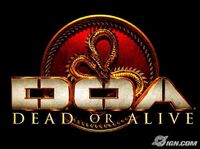
The DOA: Dead or Alive title logo.
DOA: Dead or Alive
Dead or Alive hit the big screens in 2006 with a live action film, DOA: Dead or Alive. The movie was loosely based on the game series. The film received negative reviews, and was voted #10 in Gametrailers's "Top Ten Worst Video Game Movies".
In Popular Culture
Dead Fantasy
Kasumi, Ayane, Hitomi, Hayate, Helena, and Ryu - with Ninja Gaiden characters Rachel and Momiji - went head-to-head with a select cast of characters from the Final Fantasy in Monty Oum's on-going CG movie series, Dead Fantasy. While Dead Fantasy is a unofficially, fan-made series, the movies have gained great internet success, and have been shown in various official videogame conventions such as E3.





